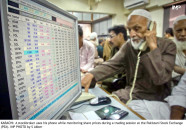Apple overtakes Samsung in shrinking smartphone market
IDC reported Apple’s market share at 19.2%, followed by 18.4% of Samsung

PHOTO: REUTERS
A survey by IDC showed Apple - which reported its quarterly data on Thursday - led all vendors with 77.3 million iPhones sold, giving it a 19.2% market share.
Even though Apple’s fourth-quarter unit sales were down 1.3% from a year earlier, it was able to move ahead of South Korea’s Samsung, whose 74.1 million devices sold gave it a market share of 18.4%, IDC said.
Huawei held the number three position with a 10.2% market share, followed by fellow Chinese makers Xiaomi and Oppo, with 7.0% and 6.8%, respectively, according to the survey.
Overall smartphone sales were down 6.3% with 403.5 million handsets shipped.
The research corporation said the data showed consumers appeared in no rush to upgrade to the most expensive flagship smartphones from Apple and Samsung.
IDC Research Manager Anthony Scarsella said, “The latest flock of posh flagships may have had consumers hitting the pause button in the holiday quarter.”
Samsung could release a S9 'Mini' next year
Scarsella said these high-end devices “proved to be more of a luxury than a necessity among upgraders.”
IDC analyst Jitesh Ubrani said that as the top brands expanded their offerings, “brands outside the top five struggled to maintain momentum.”
Samsung, which reported a 4.4% decline in the fourth quarter, remained the top smartphone vendor for the full year with a 21.6% market share, to Apple’s 14.7%.
A separate survey from Strategy Analytics found similar market share for smartphone vendors, but found a 9% drop in fourth-quarter sales, described as the largest decline in the smartphone era.
“The shrinkage in global smartphone shipments was caused by a collapse in the huge China market, where demand fell 16% annually due to longer replacement rates, fewer operator subsidies and a general lack of wow models,” said Linda Sui of Strategy Analytics.
Published in The Express Tribune, February 4th, 2018.
Like Business on Facebook, follow @TribuneBiz on Twitter to stay informed and join in the conversation.



















COMMENTS
Comments are moderated and generally will be posted if they are on-topic and not abusive.
For more information, please see our Comments FAQ